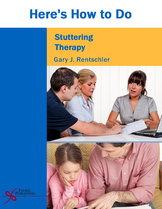Publication
Here's How to Do Stuttering Therapy
- Details:
- 175 pages, Illustrated (B/W), Softcover, 8.5 x 11"
- ISBN13:
- 978-1-59756-386-4
- Release Date:
- 09/15/2011
Overview
Survey research reveals that SLPs feel poorly prepared to treat children and adults who stutter. Here's How to Do Stuttering Therapy serves as a practical guide to provide stuttering therapy, based upon a well-articulated philosophy of the disorder. The book is a practical guide that provides readers with a solid rationale for assessment and treatment, but does not dwell on theories, philosophies, or specific programs. Rather, the orientation is toward application, while providing a justification based upon research and the information we know about stuttering.
The uniqueness of the book is the focus on applied practice and functional applications. While other books present theory and structure of therapeutic approaches, Here's How to Do Stuttering Therapy offers a hands-on, eclectic approach centered on the needs of the client, rather than the structure of any specific treatment program.
Foreword by Thomas Murry, PhD vii
Preface ix
Acknowledgments and Dedication xi
Chapter 1. Basic Clinical Skills for Stuttering Therapy
Introduction
Getting Oriented
Basic Clinical Skills
Treatment Basics
First Session Advice
Meeting the Client for the First Time
Another Perspective on Stuttering
Clients Who Have Had Therapy Before
Where to Start
Consumers of Our Services
References
Chapter 2. Childhood Stuttering
An Overview of Childhood Stuttering
Developmental Levels of Stuttering
Pertinent Facts About Stuttering
Components of Evaluation and Treatment
Characteristics of Childhood Stuttering
Evaluating Stuttering in Children
Treatment Approaches
Working with Parents
The Clinical Teaching Paradigm
Treatment Activities
Sample Treatment Plans
Support Resources
References
Chapter 3. Stuttering in Adolescents and Adults
An Overview of Adolescent and Adult Stuttering
Assessing Adolescents and Adults Who Stutter
Speech Characteristics of Adolescents and Adults Who Stutter
Affective Characteristics of Stuttering
Treatment Approaches
Working with Emotions, Anxiety, Fear, Negative Past Experiences
Working with Covert Stuttering
Determining a Starting Point for Therapy
Therapy Techniques (Targets)
Signs of Progress in Therapy
Sample Therapy Session
Organizations/Support Groups
References
Chapter 4. Activities for Stuttering Therapy
Introduction
Speech Activities
Emotive Activities
Some Activities for Speech Goals
Some Activities for Emotive Goals
Index
About The Author
Dr. Rentschler is Clinic Director at Duquesne University, where is heads the stuttering therapy program at the University Clinic. He is a Board Recognized Specialist in Fluency Disorders, and is currently serving as a Board member of the Specialty Recognition Board. Dr. Rentschler has been recognized as Speech Pathologist of the Year by the National Stuttering Association.
In addition to his role in clinical education, he teaches courses in stuttering therapy, professional ethics, and legal issues for speech pathologists. Dr. Rentschler received a Master of Arts and Doctoral degrees for State University of New York at Buffalo.
Related Titles
Clinical Decision Making in Fluency Disorders
Walter H. Manning, Anthony DiLollo
634 pages, Color Illustrations (2 Color), Hardcover, 7 x 10"
KiddyCAT Reorder Set
Martine Vanryckeghem, Gene J. Brutten
50 pages, Illustrated (B/W), Pad, 8.5 x 11"
Behavior Assessment Battery CAT-Communication Attitude Test Reorder Set
Gene J. Brutten, Martine Vanryckeghem
4 pages, Illustrated (B/W), Saddle Stitched, 8.5 x 11"
Behavior Assessment Battery SSC-ER-Speech Situation Checklist Reorder Set
Martine Vanryckeghem, Gene J. Brutten
8 pages, Illustrated (B/W), Saddle Stitched, 8.5 x 11"
Behavior Assessment Battery BCL-Behavior Checklist Reorder Set
Gene J. Brutten, Martine Vanryckeghem
4 pages, Illustrated (B/W), Saddle Stitched, 8.5 x 11"
Behavior Assessment Battery SSC-SD-Speech Situation Checklist Reorder Set
Martine Vanryckeghem, Gene J. Brutten
8 pages, Illustrated (B/W), Saddle Stitched, 8.5 x 11"
Fluency Disorders
632 pages, Illustrated (B/W), Softcover, 7 x 10"
Behavior Assessment Battery for School-Age Children Who Stutter (BAB)
Gene J. Brutten, Ph.D., Martine Vanryckeghem, Ph.D.
Illustrated (B/W), Softcover, 8.5 x 11"
Treatment Protocols for Stuttering
308 pages, Softcover, 8.5 x 11"





















